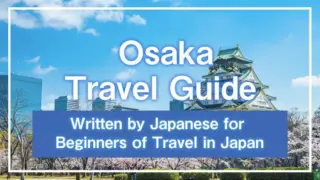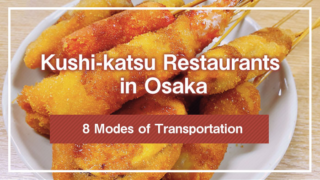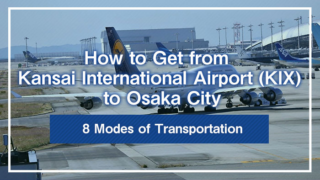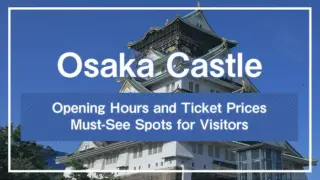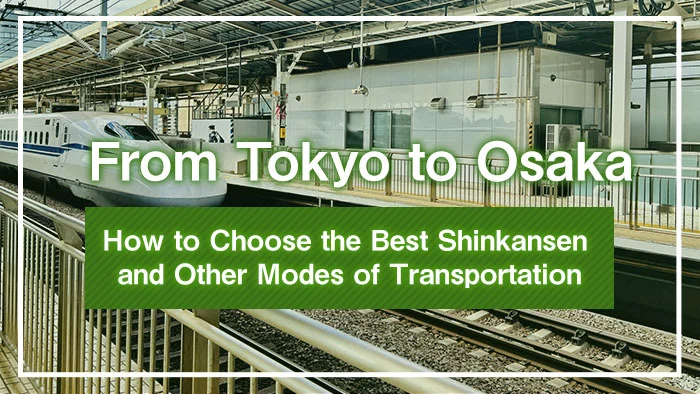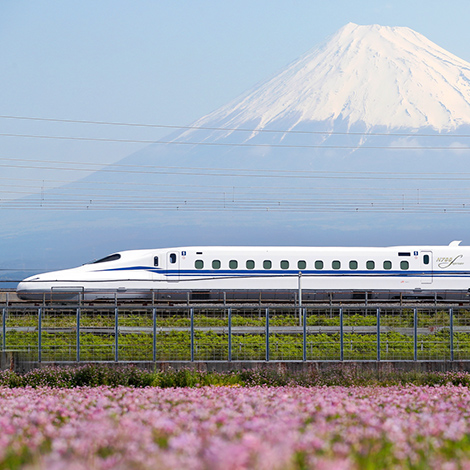The most convenient way to travel from Tokyo to Osaka is the Shinkansen. The “Nozomi” Shinkansen, in particular, allows you to make the journey in about 2 hours and 30 minutes, offering a more comfortable experience compared to airplanes or slower buses. There are various types of Shinkansen, each differing in the number of stops, travel time, and fare, so it’s important to check before you use one.
This article presents recommended types of Shinkansen for traveling from Tokyo to Osaka, including the travel time and fare for each type. If you’re looking for the best way to choose a Shinkansen from Tokyo to Osaka or exploring other modes of transportation, this guide is for you.
1.Types of Shinkansen from Tokyo to Osaka
Quote:JR Toukai
The Tokaido Shinkansen line, connecting Tokyo and Osaka, features three types of services: “Nozomi,” “Hikari,” and “Kodama.” Each service varies in terms of the number of stops, travel time, and fare, with “Nozomi” being the most popular choice for this route.
Below, we will detail the characteristics of these three Shinkansen services.
1-1.Shinkansen “Nozomi”
The Nozomi Shinkansen, launched in 1992, is the flagship train of the Tokaido Shinkansen line. It operates with a total of 16 cars, comprising 10 reserved-seat cars, and 3 cars each for Green Car reserved seats and non-reserved seats.
Nozomi’s main feature is having the fewest stops, making it the fastest option between Tokyo and Osaka. Its stops are limited to Tokyo, Shinagawa, Shin-Yokohama, Nagoya, Kyoto, and Shin-Osaka.
With up to 12 trains per hour, Nozomi offers frequent service, making it easy to catch a train without having to constantly check the timetable.
1-2.Shinkansen “Hikari”
The Hikari Shinkansen has been operating since the Tokaido Shinkansen’s inauguration in 1964. Initially, it was the fastest train on the line, known as a “super express.” After the introduction of the faster Nozomi, Hikari has served as a train connecting many more cities along the route.
Hikari trains consist of 16 cars, including 8 reserved-seat cars, 5 non-reserved-seat cars, and 3 Green Car reserved-seat cars.
One distinct feature of Hikari is the variety of stop combinations. Generally, it stops at more stations than Nozomi but fewer than Kodama, although this can vary by train.
Due to the varying stop patterns, travel times between Tokyo and Osaka on Hikari can differ.
1-3.Shinkansen “Kodama”
Like the Hikari, the Kodama Shinkansen began operations with the opening of the Tokaido Shinkansen and serves as a local train stopping at each station. It runs with a total of 16 cars, including 10 for non-reserved seats and 3 cars each for reserved-seat and Green Car reserved seats.
Kodama trains are distinctive for stopping 3 to 6 minutes at stations to be overtaken by Nozomi and Hikari services. Also, many Kodama services departing from Tokyo terminate at Nagoya rather than continuing to Shin-Osaka, so passengers should be aware of their train’s final destination.
Non-reserved seats are often available, making Kodama a recommended choice for those who prefer a less crowded journey to enjoy their travel leisurely.
2. Travel Time and Fares for the Shinkansen from Tokyo to Osaka
/
— JR東海News【公式】 (@JRCentral_OFL) December 27, 2023
明日から‼ ※1/4まで
「のぞみ」は全席指定席です📣
\
皆さまに安心してご旅行いただけるよう、
年末年始も変わらず走り続けます🚅
東海道新幹線の運行情報については、
JR東海ホームページ https://t.co/AIziYgeMpk
または@JRC_Shinkan_jpをご確認ください。 pic.twitter.com/D5jmXl9JAj
When boarding the Shinkansen, you need to purchase both a basic fare ticket and a super (limited) express ticket. If you opt for a reserved seat, you will need a special express ticket for reserved seats, which is more expensive than non-reserved seating.
Shinkansen fares vary by season, with discounts of 200 yen during off-peak seasons and increases of 200 yen during peak seasons and 400 yen during the busiest seasons.Below is the fare chart by season and the time required between Tokyo and Osaka for Nozomi, Hikari, and Kodama for your reference.
2-1.”Nozomi” Travel Time and Fares
The travel time for “Nozomi” between Tokyo and Osaka is approximately 2 hours and 30 minutes, offering the shortest journey due to fewer stops.
The regular fare for non-reserved seats on “Nozomi” is 13,870 yen, while reserved seats cost 14,720 yen. For fares during other seasons, see the table below.
During the Golden Week period from April 26 to May 6, 2024, “Nozomi” will operate entirely with reserved seating. Be aware that you cannot travel with non-reserved seat fares during Golden Week.
Reference:JR東海「2024年ゴールデンウィークにおける東海道・山陽新幹線「のぞみ」号を全席指定席として運行する期間について」
【”Nozomi” Fares】
| Non-reserved Seat | Reserved Seat | |
|---|---|---|
| Regular | 13,870 yen | 14,720 yen |
| Off-peak | 13,670 yen | 14,520 yen |
| Peak | 14,070 yen | 14,920 yen |
| Super Peak | 14,270 yen | 15,120 yen |
Reference:JRおでかけネット「運賃・特急料金早見表」
2-2.”Hikari” and “Kodama” Travel Time and Fares
As “Kodama” is an all-stops Shinkansen, it takes about 4 hours to travel from Tokyo to Osaka. On the other hand, “Hikari” often stops at fewer stations than “Kodama,” making the Tokyo-Osaka journey in about 3 hours. However, the actual travel time for “Hikari” can exceed 3 hours if it stops at more stations.
The fares for non-reserved seats on “Hikari” and “Kodama” are the same as those for “Nozomi.” However, reserved seat fares for “Hikari” and “Kodama” are 320 yen cheaper than “Nozomi,” costing 14,400 yen during the regular season.
For fares during other seasons, see the table below.
【”Hikari” and “Kodama” Fares】
| Non-reserved Seat | Reserved Seat | |
|---|---|---|
| Regular | 13,870 yen | 14,400 yen |
| Off-peak | 13,670 yen | 14,200 yen |
| Peak | 14,070 yen | 14,600 yen |
| Super Peak | 14,270 yen | 14,800 yen |
Reference:JRおでかけネット「運賃・特急料金早見表」
3.First and Last Shinkansen from Tokyo to Osaka
/
— JR東海News【公式】 (@JRCentral_OFL) January 1, 2023
新年明けまして
おめでとうございます
\
昨年は多くのお客様に東海道新幹線や在来線をご利用いただきました。
改めて、ありがとうございました。
今年も皆様に、より便利に・より快適にご移動をいただけますよう、取り組んでまいります。
本年もどうぞよろしくお願いいたします。 pic.twitter.com/83yngNcey3
The Shinkansen trains running from Tokyo to Osaka operate several times an hour, so you rarely have to wait more than 10 minutes. Here are the details on the first and last Shinkansen trains for both westbound (Tokyo to Osaka) and eastbound (Osaka to Tokyo) directions.
The first westbound train from Tokyo to Osaka departs Tokyo Station at 6:00 AM and arrives at Shin-Osaka Station at 8:22 AM. On the other hand, the last train leaves Tokyo Station at 9:24 PM, reaching Shin-Osaka Station at 11:45 PM.
For eastbound trips from Osaka to Tokyo, the first train leaves Shin-Osaka Station at 6:00 AM, arriving at Tokyo Station at 8:23 AM. The last train from Shin-Osaka Station departs at 9:24 PM and arrives at Tokyo Station at 11:45 PM.
Both the first and last Shinkansen trains connecting Tokyo and Osaka are Nozomi services, which take approximately 2 hours and 30 minutes for the journey.
4.Alternative Modes of Transportation from Tokyo to Osaka Besides the Shinkansen
1872年10月14日 新橋~横浜間
— JR東海News【公式】 (@JRCentral_OFL) October 14, 2022
ここから日本の鉄道は始まりました。
鉄道開業150年。
今日も、明日も、その先も。
私たちは皆さまの移動を支えてまいります。
これからもJR東海をよろしくお願いいたします。 pic.twitter.com/MYXW9QpGWs
Apart from the Shinkansen, there are several other ways to travel between Tokyo and Osaka:
- Express Bus
- Airplane
- Local Trains
Among these, the Shinkansen is generally the most expensive option. Below, we detail the features and costs associated with each alternative mode of transportation.
4-1.Express Bus
The express bus is one of the cheapest options for traveling between Tokyo and Osaka. The journey takes about 8 hours, typically departing late at night and arriving the following morning, which is why it’s also known as an overnight bus.
A variety of seating options are available, including 4-row and 3-row seats, allowing passengers to choose according to their preferences. Facilities such as toilets, power outlets, blankets, and privacy curtains add to the appeal of express buses.
Express buses operate routes from Tokyo Station, Shinjuku Station, and Ikebukuro Station to major stations in Osaka, including Osaka Station and Namba Station.
Fares range widely from approximately 3,600 to 20,000 yen, varying by seat type and departure date. Generally, buses with fewer seats, such as those with 2-row seating, and buses departing before holidays tend to be more expensive. Some bus companies offer round-trip discounts.
4-2. Airplane
Flying is also a recommended means of travel between Tokyo and Osaka. To use this option, you’ll need to travel from Tokyo Station to either Haneda or Narita Airport and then fly to either Itami or Kansai Airport to get to Osaka Station.
The flight time between Tokyo and Osaka is approximately 1 hour. However, you should arrive at the airport earlier than the departure time due to the time it takes to complete the boarding procedures for your flight.
Airfare varies significantly between using major airlines like ANA or Japan Airlines and low-cost carriers (LCCs) such as Peach Aviation or StarFlyer.
For ANA or Japan Airlines, ticket prices range from about 13,000 to 20,000 yen, whereas fares for LCCs are roughly between 9,000 and 12,000 yen.
4-3. Local Train
Traveling from Tokyo to Osaka via local trains takes about 9 hours one way and costs between 8,000 to 10,000 yen. Although this is an affordable option, it requires over five transfers, making it less recommended for those not accustomed to train travel in Japan.
However, for those who are not in a hurry to reach Osaka or Tokyo and wish to visit various attractions along the way, traveling by local train can be suitable. Purchasing a Seishun 18 Kippu, which allows for multiple stopovers, is particularly advantageous.
The Seishun 18 Kippu consists of five tickets for unlimited rides on local trains and costs 12,050 yen. Note that the sale and usage periods for the Seishun 18 Kippu are limited, so be mindful when planning to use or purchase it.
Reference:JR東海「青春18きっぷ」
Conclusion
There are several ways to travel from Tokyo to Osaka, such as the Shinkansen, airplane, and express bus. For the shortest overland trip, the “Nozomi” Shinkansen is recommended, reaching Osaka in about 2 hours and 30 minutes compared to the “Hikari” and “Kodama,” which take about 3 hours.
If choosing an alternative to the Shinkansen, airplanes and express buses are good options. The flight time between Tokyo and Osaka is about 1 hour, offering a quick journey and making it an appealing option. Although the express bus takes about 8 hours, it can be a more budget friendly choice.
*This article is based on information as of April 2024.

